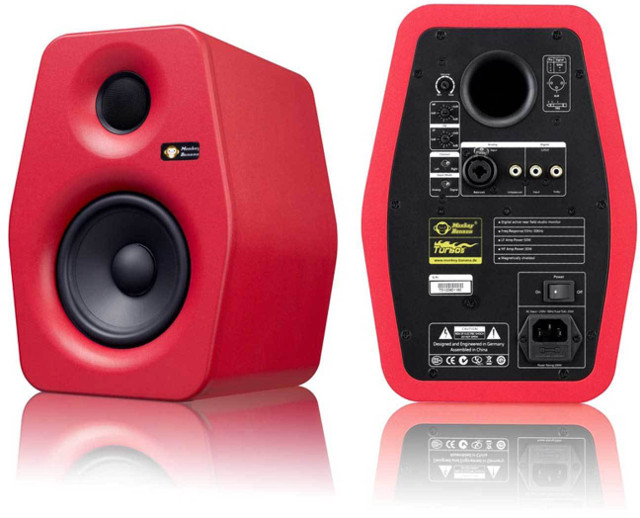The amount of near field monitors is vastly overwhelming for anyone who’s looking for a set of monitors. Especially in the price range of these Turbo 5 there are various different brands and models out there. Lately there seems to be an up rise of the models that are esthetically pleasing to the eye. To that regard the Turbo 5 stands out by its not typical square shape and availability to have them in yellow, red or black colors. Somehow these red ones remind me of not standing out on the set of the Barbarella movie with their 70-ies look. The logo that lights up when powered on does look a bit odd though.

Personally I care more about the build quality and weight of the monitors than the esthetics but some people might disagree. The build quality is rather good and the weight of the monitors indicate the size of the magnets of the woofer and are an indication of the power. To that regard these monitors are 6Kg a piece which translates to 95dB for a 50 Watt low frequency amplifier and 30 Watt high frequency amplifier. So that quite loud enough to listen to mixes at a loud level in an average bedroom although at the highest level you can hear some distortion. Not as loud as some competitors out there so your ears will like that very much. For bigger rooms you might consider up scaling to more powerful models.
These monitors are active and even bi-amped. In addition to the standard balanced analogue inputs, -6 to 6dB bass and treble potentio meters there are also digital inputs that can handle up to 24 bit 192kHz spdif. This means these speakers can be hooked up to a computer that has a on board spdif output. You can use the volume potentio meters at the back to control the maximum volume which comes in handy when using the digital inputs. You don’t see that many monitor speakers with these options.
The frequency range is from 55Hz to 30kHz with the crossover at 3kHz. This results in a fairly balanced sound and stereo image in regard to the competition. What did strike me at first that the mids are rather exaggerated. So vocals tend to put more on the foreground. It also means analyzing mixes you need to hold this in regard with the low and high frequencies. The high frequencies are not sharp at all which is not uncommon with some of the competition. The low frequencies will translate low kicks and you’ll notice the backside bass ports acting up quite much. So you have to leave some room at the back. For sub-low frequencies you’ll need an extra subwoofer.
When looking for monitors it makes sense to listen to them before choosing which type you want to get. This type would not be an exception because they are not that neutral sounding. I have listened to them for over a month now they do seem to sound fairly good from classical music to speed metal. It comes in handy you can hook them up via spdif. Yet it does make sense to be able to switch them off with one button whenever your computer decides to crash and put static on the spdif output. Loudness is not it strongest point yet they are well suited for mixing because they sound fairly detailed.
Wouter Veltmaat – Serious Mastering
